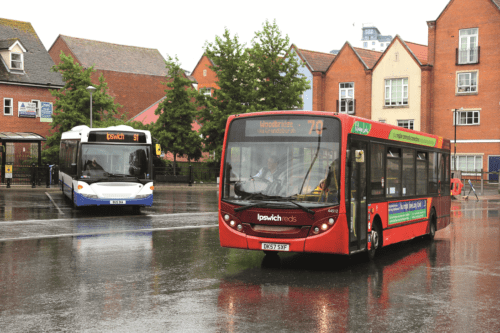
In our lead feature this week, Jonathan Welch looks at Ipswich Buses. Here, he takes a short look at some of the other buses to be found in the Suffolk town
Ipswich isn’t just home to one operator. Whilst Ipswich Buses operates the lion’s share of local services, First’s Ipswich Reds operates a network of regional services linking Ipswich to outlying villages and nearby towns such as Saxmundham, Stowmarket and Felixstowe, as well as the cross-town park & ride route 800.
The company has a depot within the town, not far from the Old Cattle Market bus station, which serves as a hub for its services, and is part of the wider First Eastern Counties operation, descended from the former National Bus Company subsidiary of the same name. It traces its roots back to the formation of the Eastern Counties Omnibus Company in 1931, a combination of four existing East Anglia operators, namely Ipswich-based Eastern Counties Road Car Company, Ortona Motor Company of Cambridge, Peterborough Electric Traction Company and United Automobile Services’ East Anglia services. The combined operation had a fleet of over 500 buses, and besides United Automobile Services and Tilling & British Automobile Traction, the London & North Eastern Railway and London Midland & Scottish Railway were also shareholders in the venture, which also encompassed Eastern Coach Works in Lowestoft. The company instigated a policy of acquiring and absorbing other operators in the area; by the end of the 1930s the company had purchased another 50 operators.
[…]By subscribing you will benefit from:
- Operator & Supplier Profiles
- Face-to-Face Interviews
- Lastest News
- Test Drives and Reviews
- Legal Updates
- Route Focus
- Industry Insider Opinions
- Passenger Perspective
- Vehicle Launches
- and much more!


